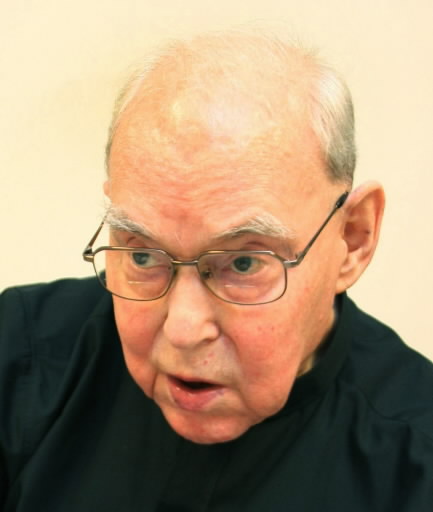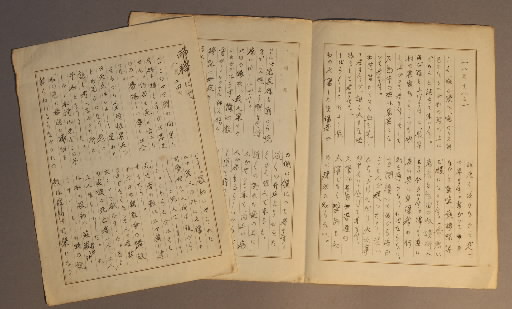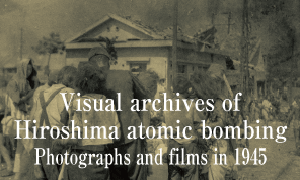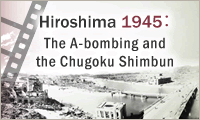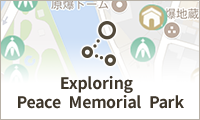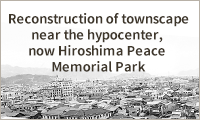Diary left by Father Klaus Luhmer, A-bomb survivor of Hiroshima, to be exhibited at Hiroshima Peace Memorial Museum
Jul. 16, 2011
by Masami Nishimoto, Senior Staff Writer
It has been learned that Father Klaus Luhmer, who passed away in March at the age of 94, left a diary, written in Japanese in the aftermath of the atomic bombing, in which he described the catastrophe that struck the citizens of Hiroshima as well as the relief efforts he joined. Father Luhmer was a native of Germany and an A-bomb survivor of Hiroshima. He was also a former professor emeritus at Sophia University. As far as has been confirmed, Father Luhmer's writing is the earliest example, following the blast, of an account made by a foreign A-bomb survivor, and thus constitutes a valuable record. The diary will be on display in an exhibition entitled “To live—August 6, 1945—from that day forth,” which will open on July 15 at Hiroshima Peace Memorial Museum.
Father Luhmer used four pages on August 18, 1945, and another two pages on August 24, to write about the day of the bombing, which occurred on August 6.
His description begins with the moment he heard the bomb explode while at the Nagatsuka Monastery for Jesuits in present-day Asaminami Ward, about 4.1 kilometers north of the hypocenter. He goes on to describe victims of the bombing rushing into the novitiate: “People suffering burns, wailing terribly, run into the monastery. They lie in the chapel, the reception room, and other places, groaning from their great pain.”
Along with the rector of the monastery, Father Pedro Arrupe, who had some medical background and would later become the Superior General of the Society of Jesus, Father Luhmer engaged in relief efforts and searched for missing priests and others who were at a church in the Nobori section of downtown Hiroshima when the bomb exploded. (Father Arrupe died in 1991.) Father Luhmer described his experience of that day: “We heard a soldier screaming, begging for water. I can't even depict the terrible scenes, lit by the blazing fire. The destruction, the dead, the dying...”
His diary entry of August 24 reveals that Father Luhmer moved temporarily to the Taishaku Valley area in the city of Shobara in Hiroshima Prefecture. This was the place to which nine “White Russians,” who had settled in Hiroshima and survived the bombing, were forced to relocate after the war.
Father Luhmer came to Japan in 1937. He began to keep a diary in Japanese in June 1945, when he evacuated from Tokyo to Hiroshima. While working as a professor at Sophia University, he continued to write in this diary, intermittently, until 1984.
In mid-February of this year, he was asked to share his A-bomb account in Tokyo. Soon after Father Luhmer shared his diary for the first time, to an acquaintance, he was hospitalized. On March 1, he died of pneumonia. Father F. J. Mohr, professor emeritus at Sophia University, among others, has lent his support to the exhibition at Hiroshima Peace Memorial Museum and loaned the diary for display.
(Originally published on July 9, 2011)
It has been learned that Father Klaus Luhmer, who passed away in March at the age of 94, left a diary, written in Japanese in the aftermath of the atomic bombing, in which he described the catastrophe that struck the citizens of Hiroshima as well as the relief efforts he joined. Father Luhmer was a native of Germany and an A-bomb survivor of Hiroshima. He was also a former professor emeritus at Sophia University. As far as has been confirmed, Father Luhmer's writing is the earliest example, following the blast, of an account made by a foreign A-bomb survivor, and thus constitutes a valuable record. The diary will be on display in an exhibition entitled “To live—August 6, 1945—from that day forth,” which will open on July 15 at Hiroshima Peace Memorial Museum.
Father Luhmer used four pages on August 18, 1945, and another two pages on August 24, to write about the day of the bombing, which occurred on August 6.
His description begins with the moment he heard the bomb explode while at the Nagatsuka Monastery for Jesuits in present-day Asaminami Ward, about 4.1 kilometers north of the hypocenter. He goes on to describe victims of the bombing rushing into the novitiate: “People suffering burns, wailing terribly, run into the monastery. They lie in the chapel, the reception room, and other places, groaning from their great pain.”
Along with the rector of the monastery, Father Pedro Arrupe, who had some medical background and would later become the Superior General of the Society of Jesus, Father Luhmer engaged in relief efforts and searched for missing priests and others who were at a church in the Nobori section of downtown Hiroshima when the bomb exploded. (Father Arrupe died in 1991.) Father Luhmer described his experience of that day: “We heard a soldier screaming, begging for water. I can't even depict the terrible scenes, lit by the blazing fire. The destruction, the dead, the dying...”
His diary entry of August 24 reveals that Father Luhmer moved temporarily to the Taishaku Valley area in the city of Shobara in Hiroshima Prefecture. This was the place to which nine “White Russians,” who had settled in Hiroshima and survived the bombing, were forced to relocate after the war.
Father Luhmer came to Japan in 1937. He began to keep a diary in Japanese in June 1945, when he evacuated from Tokyo to Hiroshima. While working as a professor at Sophia University, he continued to write in this diary, intermittently, until 1984.
In mid-February of this year, he was asked to share his A-bomb account in Tokyo. Soon after Father Luhmer shared his diary for the first time, to an acquaintance, he was hospitalized. On March 1, he died of pneumonia. Father F. J. Mohr, professor emeritus at Sophia University, among others, has lent his support to the exhibition at Hiroshima Peace Memorial Museum and loaned the diary for display.
(Originally published on July 9, 2011)

